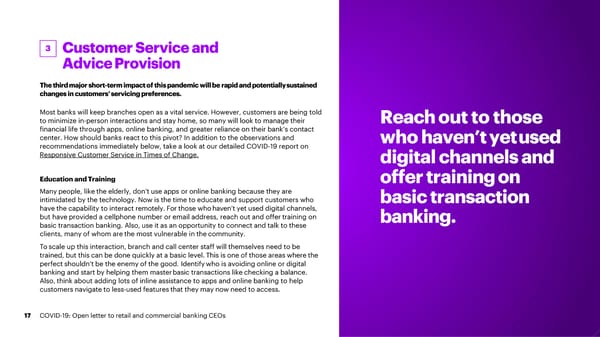3 Customer Serviceand AdviceProvision The third major short-term impact of this pandemic will be rapid and potentially sustained changes in customers’ servicing preferences. Most banks will keep branches open as a vital service. However, customers are being told to minimize in-person interactions and stay home, so many will look to manage their Reach out to those financial life through apps, online banking, and greater reliance on their bank’s contact center. How should banks react to this pivot? In addition to the observations and who haven’t yetused recommendations immediately below, take a look at our detailed COVID-19 report on Responsive Customer Service in Times of Change. digital channels and Education andTraining offer training on Many people, like the elderly, don’t use apps or online banking because they are intimidated by the technology. Now is the time to educate and support customers who basic transaction have the capability to interact remotely. For those whohaven’t yet used digital channels, but have provided a cellphone number or email address, reach out and offer training on banking. basic transaction banking. Also, use it as an opportunity to connect and talk to these clients, many of whom are the most vulnerable in thecommunity. To scale up this interaction, branch and call center staff will themselves need to be trained, but this can be done quickly at a basic level.This is one of those areas where the perfect shouldn’t be the enemy of the good. Identifywho is avoiding online or digital banking and start by helping them masterbasic transactions like checking a balance. Also, think about adding lots of inline assistance to apps and online banking to help customers navigate to less-used features that they may now need to access. 17 COVID-19: Open letter to retail and commercial banking CEOs
 How Banks Can Manage the Business Impact: COVID-19 Page 16 Page 18
How Banks Can Manage the Business Impact: COVID-19 Page 16 Page 18